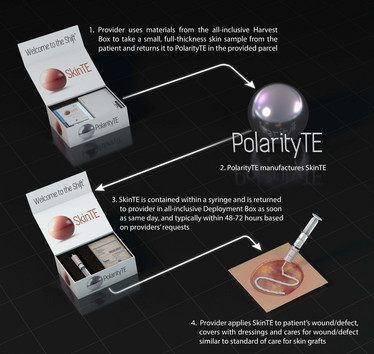The Skin Synthesizers
How functionally polarized full-thickness tissue regeneration, artificial intelligence and advanced 3D printing hold the keys to advanced wound repair.
The regenerative medicine battleground is littered with the corpses of failed companies and concepts – perhaps an unavoidable consequence of fighting at the boundaries of current scientific understanding and technology. The field of wound healing is no exception, with researchers struggling to translate promising in vitro data into patient care.
Here, we present two stories of researchers who, despite the challenges, continue to push the limits of what’s possible by embracing technological advances and following long-held dreams.
Patient-specific wound-healing
Denver Lough is a plastic surgery trained medical doctor and also the CEO of Polarity TE, a biotechnology company based in Salt Lake City, Utah, USA (1). Learning from and thinking differently about existing research in the regenerative medicine field that he studied at Georgetown University and then Johns Hopkins University, Lough is acutely aware of the real consequences of success and failure. Branching out from the traditional model of regenerative medicine that involved a single stem cell, scaffold or growth factors, Lough instead envisioned a solution that relied more closely on the natural capacity of a patient’s own body. “We recognized very quickly that our technology, successfully implemented, could have a real impact on patients’ lives,” he says. “Partly in response to a massive explosion in Taiwan in 2015 (2), in which over 500 young people were horrifically burned, we decided to do something crazy – and bite the translational bullet to launch PolarityTE.”
Lough believes one longstanding stumbling block to translation has been a widespread, misguided attempt by the scientific community to reduce complex biological systems down to their constituent parts. “It’s becoming increasingly apparent to everyone in the field that, though the central dogma of cellular biology – the transfer of genomic information to the transcriptome and ultimately the proteome – is incredibly important, you can only glean so much information from these data,” says Lough. “You can’t necessarily just take a bottom-up approach – you have to be able to take a more dynamic path.” To that end, Lough and his team developed a concept based on what he terms “minimally polarized functional units” (MPFU). “The core to our technology is that we don’t disrupt the complete interactome, which is the complex network of interactions between our cellular components,” he says. “You simply cannot disrupt interactions with other cells, with growth factors, with metabolite gradients, and cell shape and morphology, if you’re aiming for real success.”

And Lough can also walk the walk: the company’s first product – SkinTE – was registered with the FDA in late 2017 (3). The process involves first taking a small skin sample from a patient, which is used to create the individualized SkinTE product. SkinTE allows endogenous regenerative capacity to essentially be re-activated. The SkinTE product is a paste-like substance that is applied to the wound site, driving tissue repair on the patient over time. At a recent meeting of the American Burn Association in Las Vegas, PolarityTE presented a case study on one of a number of patients successfully treated with the new technology (4). According to Lough, this is just the first step for the technology. “We’re working to expand our portfolio of core TE’s to include components such as bone and cartilage, as well as internal tissues,” he says. “But we also want to go further, and explore whether or not we can alter these constructs using gene therapy approaches, or use them in bioreactors, or make them immune tolerant.”
The ultimate goal? To create a composite tissue system, capable of being applied directly into the site of a wound and repairing multiple types of tissue at once. Lough recognizes this will be a considerable technical challenge. “The issue right now is that we are still quite limited in technological terms,” he says. “We need to be able to capture information that is highly complex in nature, and assess it appropriately.” Artificial intelligence may hold the answer to that particular problem. “High-throughput application of big data is key to being able to really understand all the intricacies of the interactome and to mastering a more granular understanding of how a particular molecule is effecting the entire system, rather than a single pathway,” says Lough. He sees AI giving researchers the potential to assess massive amounts of data in real time and, in doing so, get closer to understanding all the dynamic and kinetic elements of living systems.
Beyond the ongoing focus on translational science, Lough is passionate about maintaining the company’s ideology in the face of external pressures. He recalls early decisions to turn down traditional avenues of capital: “We met a whole host of venture capital funds who were highly focused on getting us a multiplier and an exit,” he says. “But that didn’t mesh with our ethos. We wanted to accelerate the technology as fast as we could, so that we could bring it to as many people as possible.” Part of that approach has been the development of small, self-contained production facilities located in major urban areas. “These are fully scalable and deployable modular manufacturing facilities that can be placed around the globe – even within existing medical infrastructure,” explains Lough.
But Polarity TE is not the only platform on the block, when it comes to wound repair.
Inkjet inspiration
Other key players in the tissue engineering field are working with another emergent technology: advanced 3D tissue printing. Sean Murphy is an Assistant Professor at the Wake Forest School of Regenerative Medicine, North Carolina. “Our earliest work in the field was based on printing bilayers of skin, or cardiac tissue, and other very simple types of construct. We’ve always been enamored by the idea of printing whole tissue constructs directly in the site of wounds,” he says.
And so, the question Murphy and his team pondered for some time was whether they could develop such a complex 3D printing platform. The resulting technology, developed in conjunction with the US Department of Defense, has proven to be significantly less invasive than traditional skin grafts, requiring only a small biopsy (approximately the size of a postage stamp). Murphy explains the process: “We examine the wound using a tissue scanner that we can move over the wound to produce a 3D image of the tissue. We then feed that information into a computer, which tells us exactly where different cell types should go and generates a layer-by-layer ‘print’ path,” he says. This information feeds into an ‘inkjet’ style printer, which is adapted with multiple cartridges and printer heads, and is capable of delivering layers of cells – extracted, isolated, and grown up in culture from the biopsy – with a remarkable level of precision (5).
“The printer is currently designed to use six different print heads that can be interchanged at will,” Murphy says. “In these early studies, we only looked to incorporate fibroblasts and keratinocytes – two of the more abundant cell types (6) – into our wound repair models, but in the future we would like to treat deeper and more complex wounds, depositing muscle, fat, or even bone, all at the same time.”
Though a number of technical hurdles will have to be overcome before the technology can enter routine clinical use, Murphy sees the potential for even wider application: “It could be combined with technologies, such as those which repair cartilage in the knee, or internal injuries. You might even be able to repair damage caused by surgery in real time by coupling the printer with surgical tools.”
For now, all attention is focused on proving the platform’s safety and efficacy in human patients. “We need to work with the FDA to determine a pathway into clinical trials,” Murphy says. “At the same time, we’re looking to expand the work we’ve previously carried out with the US Department of Defense, to see how the technology can be used to help our wounded servicemen,” he says.
The road to translation
Emerging technologies, including AI and 3D printing, are presenting translational scientists with new routes into the clinic. With an expanding toolbox, a clear goal and high motivation, the latest class of biomedical engineers appear to be optimistic that real breakthroughs are possible – at least in the field of wound repair.
- PolarityTE, “Functionally-Polarized Tissue,” (2019) Available at: www.polarityte.com Accessed April 9, 2019.
- BBC News, “Taiwan Formosa Water Park explosion injures hundreds,” (2015). Available at: bbc.in/2P4ltqK. Accessed April 11, 2019.
- MS Granick et al., “In vivo expansion and regeneration of full-thickness functional skin with an autologous homologous skin construct: Clinical proof of concept for chronic wound healing,” Int Wound J, Epub ahead of print, (2019). PMID: 30868746.
- PR Newswire, “PolarityTE Hosts Symposium Featuring SkinTE-Treated Burn Survivor, New Clinical Data at American Burn Association Annual Meeting,” (2019). Available at: prn.to/2VHhOBS. Accessed April 11, 2019.
- M Albanna et al., “In situ Bioprinting of Autologous Skin Cells Accelerates Wound Healing of Extensive Excisional Full-Thickness Wounds,” Nature Sci Rep, 9, 1856-1870, (2019). PMID: 30755653.
- M Boer et al., “Structural and biophysical characteristics of human skin in maintaining proper epidermal barrier function,” Postepy Dermatol Alergol, 33, 1-5, (2016). PMID: 26985171.
















